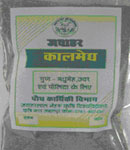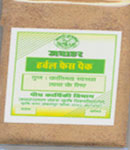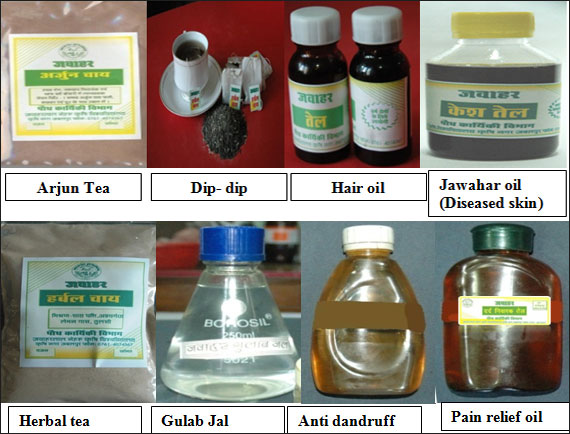Research in field crops
Rice (Oryza sativa L.)
- Application of Humic substance improved plant height, tiller number, seed number, filled panicle grain, biological yield and harvest index which ultimately resulted in maximum realization of yield potential.
- Soil application of Humic substance @ 20 kg/ha + PGPR @2.5kg/ha + VAM @ 2.5 kg/ha + organic manure @ 375 kg/ha + RDF, (12 : 50 : 30 kg NPK/ha + 16 kg ZnSo4) enhanced 18.75% seed yield over control.
Maize (Zea mays L.)
- Genotype KAVERI, SUPER 244 accumulated maximum dry matter in leaves, flag leaves and cobs with maximum duration of reproductive phase resulting in higher plant height, cob number/ plant, grain number/ cob, cob length and cob girth reflecting in higher grain yield.
Soybean (Glycine max (L.) Merrill)
- JS 20-42 and JS 93-05 had maximum reproductive phase while JS 20-35 and JS 20-41 took maximum days for seed filling.
- Genotype JS 97-52 outyielded the other genotypes with maximum plant height, number of branches, pod number/plant and seed index which compensated less pod number with higher yield.
Chickpea (Cicer arietinum L.)
Seed Enhancement
- Seed rate of 45kg/ha is sufficient for obtaining higher economic yield and yield attributing parameters Thiomethaxam @ 3 kg/ha + vitavax @ 2 kg/ha protected the seeds from insect and fungal infestation and enhanced physiological activity.
Drought tolerance
- G 130, Rajas and Vishal were promising for seed yield and its attributes under drought conditions.
- The RWC is an indicator for susceptibility or tolerance capacity for drought.
- Low drought susceptibility index along with higher drought tolerance efficiency is a criteria for screening for drought tolerance.
- Under high temperature (HT) 30 genotypes had been grown.
- ANNEGIRI and K 850 genotypes performed better under HT environments.
- Both genotypes were reported for early flowering poding.
- ANNEGIRI was reported for high yield under late sown conditions.
Mungbean (Vigna radiata (L.) Wilczek)
- Application of 100% RDF + Vermicompost @ 1.21/ha + Rhizobium 3kg/ha significantly improved physiological growth determinants, photosynthetic rate, chlorophyll index and morpho-physiological structural components of productivity and seed yield.
Pigeon pea (Cajanus cajan (L.) Millisp)
- Foliar application of Paclobutazol @ 90 ml/ha at 60 DAS improved the morphological structural attributes, enhanced seed yield by 26.90% over control.
Laboratory screening for flooding tolerance of pigeon pea germplasm lines
- Seed deterioration began after 96 hours of submergence with reduction in germination.
- ICPL 2039 exhibited maximum tolerance with higher germination percentage.
Pot screening for flooding tolerance of pigeon pea germplasm lines
Eight days after drain out of water logged plots
- ICPB 2039 had maximum survival percentage and relative water content.
- KPBR 80-2-1 attained maximum plant height, chlorophyll index and dry matter production.
- Root capacitance was maximum in JBP 110-B.
Field screening for flooding tolerance of pigeon pea germplasm lines
- Maximum survival percentage was noted in KPBR 80-2-1.
- Chlorophyll index was maximum in ICPL 8705
- Root capacitance was maximum in ICPL 20092 and UPAS 120.
Niger (Guizotia abyssinica L.)
- Significantly higher plant height, node number, seeds / capitulum, seed index, biological yield and harvest index were achieved by application of RDF (30+20+12 kg NPK/ha).
Wheat (Triticum aestivum L.)
- Among twenty nine genotypes investigated NIAW 1395, NI 153, MP 3349, MP 3222, MP 3346, MP 3020 and MP 3336 were promising for green yield and its attributes under restricted irrigation conditions.
- High RWC and chlorophyll content are the indicators for temperature tolerance capacity and utilized for development of temperature tolerant varieties under rainfed conditions.
Bajara (Pennisetum glaucum L.)
- Genotype Giant bajra possessed maximum dry matter, water utilization, radiation and water use efficiencies.
- AVTPM 1 had maximum chlorophyll index and protein %.
RESEARCH IN MEDICINAL AND AROMATIC PLANTS
Ashwagandha (Withania somnifera)
- Optimum dose of inorganic & biofertilizer 75% NPK of RDF kg/ha (50:30:30) and FYM @ 10 tones /ha with an optimum plant spacing 30X 30 c.m.
- Foliar spray of salicylic acid @ 20ppm improved yield, Withanolide A content and proximate parameters of dry root.
- Foliar application of Methanol @ 40 ml/lit. increased Withanolide B and Withaferin A.
- Maximum Withaferin was observed in roots after 90 days after of sowing.
- Chromatogram of Withanolide A & B by HPLC
- Harvesting at 110 days after sowing accumulated maximum Withanolide.
Isabgol (Plantago ovata)
- Row spacing of 35cm, 50% NPK of RDF kg/ha (50:25:30), Azatobacter and PSB @ 3 kg/ha each and FYM @ 5 tones/ha is optimum dose to enhance quality and yield.
- Last week of October is the optimum date of sowing.
Tulsi (Ocimum spp.)
- Salicylic acid @ 100 ppm increased the eugenol content by 25%.
- IC 369247 showed best performance in economic yield and quality.
Coleus (Coleus forskohlii)
- FYM, vermicompost, sand and coco peat in a ratio of 1:1:1:1 enhanced root numbers, length, diameter and dry root yield.
- NPK 50:50:30 kg/ha FYM @ 5 tones / ha, 2.5 tones vermicompost and Azotobacter attained maximum fresh and dry yield and forskolin content.
Chandrasur (Lepidium sativum)
- Optimum time of sowing Chandrasur for realizing maximum yield is mid October.
- NPK @ 50:50:30 and 10 tones of FYM enhanced seed yield by 10% over control.Sinapic Acid Standard by HPTLC
- Germplasm MLS 1002 exhibited maximum seed yield and Sinapic acid.
Safed musli (Chlorophytum borivilianum)
- 20 tones of FYM / ha with a spacing of 30 x 10 cm and 15cm high ridges attained maximum dry root yield.
- Harvesting of roots between 160-170 days after planting influences Saponin content.
- Saponin by HPTLC
- Shade drying of leaf and storage of leaf powder in 150 gauge polythene bags retained quality of root and Saponin content.
Kalmegh (Andrographis paniculata)
- Optimum plant geometry for plant to plant distance is 50cm.
- 20ppm NAA, Azatobactor and PSB @ 3Kg/ha improved leaf dry weight and Andrographolide content.
- Maximum Androgropholide accumulated due to 25% moisture stress upto 120 days after sowing.
Chitrak (Plumbago zeylanica L.)
- 80% water stress has influenced root length, plumbegin and proline content.
- Increasing level of water stress progressively reduced vegetative growth and biomass production.
Buch (Acorus calamus)
- Optimum planting time for maximum rhizome yield is last week of July.
- β-Asarone in rhizomes powder is 0.36% and in leaves 0.20%.
Post Harvest Processing
Ashwagadha (Withania somnifera)
- Harvesting of leaves at 50% flowering stage (110 DAS) yielded maximum Withaferin content.
- Maximum Withanolide A & B were estimated at 150 DAS in root.
- Storage of root powder in glass container maintains its shelf life till 10 months.
- The optimum suitable temperature for storing Ashwagandha seed is 200C.
- Aluminum foil paper packets are the best for storing seeds.
Kalmegh (Andrographis paniculata)
- Maximum andographolide content was found at 120 DAS in dry leaves (3.02%) followed by fresh leaves (2.74%).
Senna (Cassia augustifolia)
- The optimum leaf picking time for maximum senoside A & B is 90 DAS.
- Black polythene and Aluminum foil paper packet retain the quality of Senna leaf powder during storage for longer period.
- Isolation and Standardization of protocol for active ingredients of MAPs
- Isolation of standards

Technology generated modified protocols for estimation of active ingredients in MAP have been standardized protocol by HPTLC & HPLC
| Species |
Isolated compound |
Purity |
| Coleus forskholi |
Forskolin |
85% (Fluika 95% standred) |
| Andrographis panniculata |
Anderographaloide |
82% (95% Natural Remedy) |
| Acorus calamus |
β - asarone |
85% (75% Natural Remedy) |
| Aloe barbadecsis |
Aloin |
64% (95% Sigma) |
| Species |
Active Ingradient |
Species |
Active Ingradient |
| Chorophytum brivallinium |
Saponin |
Withenia somenifera |
Witheferin A, Withanolide A&B |
| Bacopa monnieri |
Bacoside |
Lepidium sativum |
Sinapic acid |
| Ocimum santum |
Eugenol |
Plumbago zylenica |
Plumbagin |
| Glycyrrhiza glabra |
Glycyrrhizin |
Andrographis panniculato |
Andrographis |
| Coleus forskholi |
Forskolin |
Cassia augustifalia |
Senoside A&B |
| Acorus calamus |
β –asarone |
Phyllanthus amarus |
Phyllanthin |
| Aloe barbedensis |
Aloin |
Withenia somenifera |
Witheferin A, Withanolide A&B |
| Andrographis panniculato |
Andrographis |
Capsicum anum |
Capsaicin |
| Coleus forskholi |
Forskolin |
Acorus calamus |
β –asarone |
| Lepidium sativum |
Sinapic acid |
|
|
Commercialization Of Herbal Products
Single Component Value Added Products
| Parijaat Powder
Uses - Sciatica, eliminates cough congestion |
 |
| Nirgundi Powder
Uses - Strengthen hair, reduce swelling, nausea, cures swollen joints and relieves pain |
 |
| Ashwagandha Uses -Counteracts stress effects, inhibit inflammations, improve memory, general weakness, arthritis |
 |
| Bhui Amla
Uses - An efficient liver tonic |
 |
| Kalmegh Powder
Uses - Hepatic stimulant, blood purifier, cure of turbid liver, jaundice, malaria and other critical fever. |
 |
| Bel Powder
Uses – Control stomach disorder, vomiting and sun stroke |
 |
| Meethi Tulsi
Uses – Natural sweetness |
 |
Multi Component Value Added Products
| Jawar Nashak Powder
Ingredient -Giloy, Tulsi powder, Kalmegh
Uses - Controls fever |
 |
| Madhumeh Nashak Powder
Ingredient -Kutaki, Giloy, Kalmegh, Gudmar, Ashwagandha, Bel Powder, Harra, Baheda, Anola, Menthi, Bitter gourd, Jamun and Tulsi Powder
Uses- Digestive and carminative Antidote for diabetes |
 |
| Herbal Face Pack
Ingredient -Multani mitti, Aloe leaf powder, Dry rose petal, and Lime skin powder, Sandal wood powder
Uses- Shiny and glowing skin |
 |
| Herbal Balm
Ingredient -White petroleum jelly, Eucalyptus oil, Mentha oil, Tulsi oil
Uses - Headache, Body pain |
 |
| Amrat Dhara
Ingredient -Pipermint, Thymol, Camphor
Uses - Nausea, vomiting and abdominal disorders and sun stroke |
|
| Aloe vera Gel
Ingredient -Leaf pulp, preservatives and essence
Uses - Effective against skin tanning, growth and shiny skin |
 |
| Aloe vera Juice
Ingredient -Aloe pulp, sodium benzoate, water
Uses - Anti-bacterial, purgative, stomach tonic |
 |



